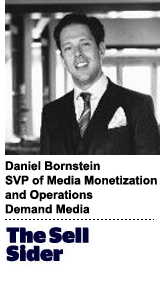 “The Sell Sider” is a column written by the sell side of the digital media community.
“The Sell Sider” is a column written by the sell side of the digital media community.
Today’s column is written by Daniel Bornstein, senior vice president of media monetization and operations at Demand Media.
While the merits of programmatic direct have been widely discussed, its adoption has been nascent.
If we can agree that the automation of a principled one-to-one relationship is valuable, what, as an industry, do we need to do to push things forward?
We could start with consensus for the name. “That which we call a rose by any other name would smell as sweet,” Shakespeare wrote, which is to say, the name is immaterial when considering what a rose really is.
In ad tech, however, names are important. The ability to define something in a ubiquitous way leads to a common understanding of what it is, helping to combat confusion and promote adoption. Nonetheless, the industry seems awash in a myriad of buzzwords that do confuse prospective consumers. The IAB has attempted to simplify the nomenclature for us by offering the term automated guaranteed.
The IAB also references other terms, such as programmatic guaranteed, programmatic premium, programmatic direct and programmatic reserved. For the purposes of automating an insertion order (IO) process and accessing direct sold inventory, perhaps the simpler “programmatic direct” suffices.
Still Not A Zero-Sum Game
Publishers tend to blame everyone but themselves for the slow rate of programmatic adoption. Agencies aren’t adapting fast enough, ad tech vendors are confusing both sides and creating a lot of noise and platforms are wielding too much power.
Publishers have made a fair amount of progress. The chasm between programmatic and selling ads directly is eroding every day. Publishers, such as Vox, once panned programmatic but now embrace it. Other sites famously went programmatic-only and are now accentuating their unique value propositions with brand evangelists.
If we want to see a spike in programmatic adoption, publishers need to promote their programmatic direct offerings with a sense of urgency. Moving media buyers from IO-based buying on to the platforms will create the market. If every publisher moved its IO business to these platforms, site discovery would benefit every publisher (and advertiser) within the ecosystem.
Pricing And The Ad Tech Tax
There are many valuable vendors that service the buy and sell sides. In programmatic, however, there can be a lack of transparency on fees.
A now-infamous IAB report shed light on the fact that only 45 cents of every dollar spent by advertisers made its way to publishers. The release of the Fee Transparency Calculator earlier this year shed further light on the topic.
Programmatic direct offers both publishers and advertisers a valuable transacting conduit with a smaller tax base and the hopeful promise of unadulterated transparency. With these variables at play advertisers should not pay more for reserving the best impressions and publishers should be able to charge the true worth of their inventory – there is no reason that a publisher’s programmatic direct offering should be priced lower than its IO-based offering.
Platform Consolidation
There are times for consolidation and times for competition – and this is a time for the former. The realization of an overarching programmatic direct marketplace favors both advertisers and publishers and would lead to faster adoption.
As long as the tax base remains fair and transparent, competition only serves vendors looking to grow larger, all-encompassing programmatic platforms or those looking to make a quick buck (by offering myriad products to create unnecessary competition).
Header Bidding, RTB And Data
Open exchange environments and private marketplaces have a lot to offer in the programmatic space but it’s clear that as long as context and audience are both important, reserving guaranteed impressions will always be of value to the buy side. There is no uniform value for an impression and header bidding, as an example, can greatly benefit the buy side by giving it an opportunity to more accurately cherry-pick the impressions deemed most valuable for individual buyers.
Programmatic direct should not negate this activity. In an ideal world, historical data will inform the advertiser of value and that value should precipitate the desire and need to reserve a given publisher’s inventory ahead of time, based on proven quality of audience, performance and context.
Similarly, publishers’ usage of first-party data in tandem with unique context and editorial will be enticing. The nascency of programmatic direct is not insurmountable.
Follow Demand Media (@demandmedia) and AdExchanger (@adexchanger) on Twitter.










